
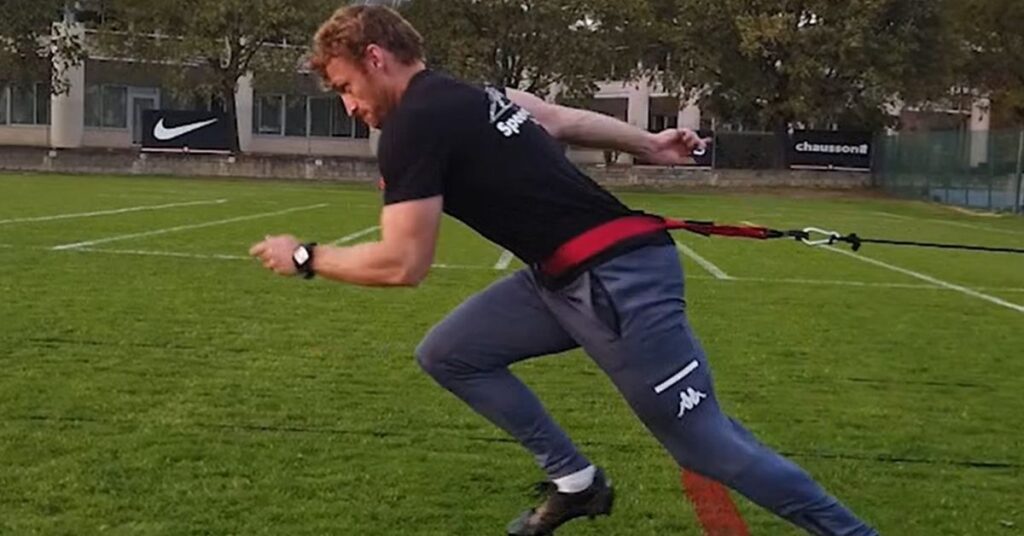
Resisted dash coaching (RST) has been a part of a coach’s repertoire for many years,1–3 with analysis displaying the advantages of RST on dash efficiency, particularly within the early acceleration part.4–5 Coaches have traditionally used three foremost strategies when prescribing RST masses:
- A load that could be a sure share of the athlete’s physique weight (%BW).
- A load to elicit a lower in velocity in comparison with the athlete’s maximal velocity. Recognized extra merely as velocity decrement (%Vdec).
- Absolute load (kg).
Relying in your scenario (funds, time, and/or house), you could be obliged to make use of one methodology over the opposite. There have been quite a few research analyzing RST in a bid to assist coaches decide what resistances to make use of. The examine by Cross et al.6 discovered that the loading required to maximise energy ranged from 69% to 96% of physique weight. One other examine by Cahill et al.7 discovered masses that triggered a sure %Vdec differed between people.
These research present us that RST just isn’t so simple as placing 20kg on a sled and anticipating the identical variations throughout a bunch of athletes. Due to the event of know-how such because the 1080 Dash, it’s now doable to simply and precisely profile athletes and program load.
Resisted sprint training is not as simple as putting 20kg on a sled and expecting the same adaptations across a group of athletes, says @jonobward. Click To Tweet
I’ve been lucky sufficient to have had entry to a 1080 Dash for the final 5 seasons. My programming on the 1080 Dash comes from studying and talking with different coaches, experimenting, and placing my twist on “stolen” concepts. Earlier SimpliFaster articles on RST have helped form my strategy to how I take advantage of the 1080 Dash, together with:
Lastly, I’ve to provide props to Dr. Julian Alcazar, who created this free, ready-made template to calculate %Vdec. I’m at all times grateful when smarter people share their work, because it makes my job that a lot simpler!
On this article, I’ll share:
- How I take advantage of the 1080 Dash with my group.
- Two totally different strategies I take advantage of to profile my athletes.
- How I program resisted sprints.
- The outcomes I’ve had utilizing the 1080 Dash.
1. Utilizing the 1080 Dash at Provence Rugby
To set the scene, I work in skilled rugby union in France with a squad of 40+ gamers. I primarily use the 1080 Dash within the gymnasium, the place there’s a artificial turf of 28 meters. I can transfer some tools to extend the gap by 5 meters to provide the athletes more room to decelerate, however this isn’t at all times doable.
The in-season interval lasts 10 months, and the group usually has 2–3 gymnasium classes per week, relying on turnarounds between video games. These classes are cut up into two teams, the forwards and backs. The gymnasium classes are roughly 50 minutes and sometimes are adopted by a area session. This implies I can’t stretch out the classes. Because of this, I have to be good with my timing and exact in my programming.
The 1080 Dash can present resisted resistance along with help, and the resistance will be mounted or variable. For these of you who’re unfamiliar with what meaning, here’s a breakdown in easy phrases:
- Resistance = You’re the one pulling the 1080 Dash twine.
- Help = You’re the one being pulled by the 1080 Dash twine.
- Mounted Resistance = The load stays the identical all through the run. For instance, you’re working 20m with a resistance of 15kg. You pull 15kg from the primary meter to the final.
- Variable Resistance = The load can change all through the run. For instance, you’re working 20m with a beginning weight of 20kg and program the tip weight to be 10kg. Your first meter shall be with 20kg, and the burden will get progressively lighter all through the run, whereby you end the 20m pulling 10kg.
There are extra specifics round how one can set the variable resistance—i.e., if you’d like the drop-off in weight to be fast or gradual—however I’ll cowl that later within the article.
Familiarization with the 1080 Dash:
Earlier than profiling my athletes, all of them have a four-week familiarization block on the 1080 Dash. A few of my athletes have been utilizing the 1080 Dash for 5 years, whereas new athletes could have by no means used the machine. The aim of this familiarization block is to:
- Construct RST capability.
- Develop into acquainted with the resistance of the 1080.
- Develop into acquainted with the circulation of the 1080 inside the gymnasium session.
- Cancel out any “beginner positive factors” which might be seen as one will get extra acquainted with the 1080. All through the primary couple of weeks, you’ll typically see athletes enhance their scores drastically as they turn out to be accustomed to sprinting with the machine.
There are two strategies I’ve used for my familiarization blocks.
Familiarization Technique #1, which I take advantage of earlier than the Load Energy Profile (LPP) methodology.
- Week 1: 1 x 10m @ 10kg / 1 x 10m @ 15kg / 1 x 10m @ 20kg
- Week 2: 1 x 10m @ 15kg / 1 x 10m @ 20kg / 1 x 10m @ 25kg
- Week 3: 1 x 10m @ 15kg / 1 x 10m @ 20kg / 1 x 10m @ 25kg / 1 x 10m @ 30kg
- Week 4: 1 x 10m @ 21kg / 1 x 10m @ 24kg / 1 x 10m @ 27kg / 1 x 10m @ 30kg
As you’ll be able to see, the gap stays at 10 meters, with the masses getting regularly heavier every week. The final week makes use of the identical weights that shall be used throughout the LPP. This permits me to take a look at how the athlete responds below these heavier masses and probably cut back the burden they may use throughout their LPP. That is usually the case for youthful or lighter athletes.
Familiarization Technique #2, which I take advantage of earlier than the Load Velocity Profile (LVP) methodology.
- Week 1: 1 x 5m @ 21kg / 1 x 10m @ 15kg / 1 x 15m @ 10kg
- Week 2: 1 x 5m @ 24kg / 1 x 10m @ 18kg / 1 x 15m @ 10kg
- Week 3: 1 x 5m @ 27kg / 1 x 10m @ 24kg / 1 x 15m @ 15kg / 1 x 20m @ 10kg
- Week 4: 1 x 5m @ 30kg / 1 x 10m @ 27kg / 1 x 15m @ 15kg / 1 x 20m @ 10kg
As you’ll be able to see, the gap will get longer, and the burden will get lighter. I solely use 20m in my familiarization block resulting from house on the artificial turf within the gymnasium, which provides the athletes sufficient time to decelerate. If I dash my athletes for longer and cut back the deceleration distance, some begin decelerating earlier than the tip of the run as a result of they’re anxious about not having sufficient time to decelerate safely.
A limitation of the primary version of the 1080 Dash is that it solely permits as much as 30kg of resistance. Whereas for the typical Joe, this shouldn’t pose an issue, for skilled athletes, you could discover that 30kg just isn’t sufficient to elicit max energy (Pmax). Later within the programming half, I’ll contact on how I get round this, however apparently, the second version of the 1080 Dash permits as much as 45kg of resistance!
2. Load Velocity and Energy Profiling
The fundamental premise of profiling is to dash your athletes utilizing totally different resistances and report the speed or energy. In case you are finishing an LVP—the important thing right here being velocity—you need your athletes to have achieved max velocity earlier than the tip of the dash. Due to this fact, you must select a distance the place this may happen.
For a Load Power Profile, use the same distance for each sprint while making sure the distance is long enough for the athlete to create relatively high amounts of power, says @jonobward. Click To Tweet
In case you are finishing an LPP, you’ll use the identical distance for every dash whereas ensuring the gap is lengthy sufficient for the athlete to create comparatively excessive quantities of energy. You want a protracted sufficient distance to make sure a transparent differentiation in energy output throughout totally different masses, which helps to establish the load that generates peak energy.
The LVP and LPP every have their strengths and weaknesses, and every will produce barely totally different outcomes. Ultimately, you could ask your self what fits your scenario greatest and whether or not you’re okay with accepting a small deviation in outcomes.
Selecting the profiling methodology that you’ll use is determined by:
- What number of athletes do you may have?
- How a lot time do you may have?
- How a lot distance do you may have accessible to dash maximally and decelerate safely?
In my scenario, I’ve one 1080 Dash and 40+ athletes. Because of this, I cut up up the profiling all through the week. I received’t acquire any pals within the tutorial world by profiling over totally different days and totally different circumstances (morning vs. afternoon, and so on.), however that is the true world. Within the first session of the week, I take a look at the entrance row and second row from the forwards group and the halves from the backs group. Within the second session of the week, I take a look at the again row from the forwards group and the facilities and outdoors backs from the backs group.
The instance profiles I’ve included beneath are from the identical athlete. He was lately injured (hand), which allowed me to make use of him as a guinea pig. For these , he’s a 26-year-old flanker who weighs 105.4 kilograms. I additionally ensured enough relaxation time (a minimum of three minutes) between every dash. He accomplished the LPP on sooner or later and the LVP on one other.
Load Energy Profile
Distance: 4 x 10m
Loading: Incremental 21kg, 24kg, 27kg, and 30kg.
Calculate LPP: To calculate the LPP, I take the load that elicited Pmax and assume that the athlete achieved 50% of their max velocity throughout this dash.
As a result of I’m utilizing peak energy and never peak pace to calculate my LPP, I don’t have to dash my athletes over longer distances to acquire a peak velocity. Additionally, 95 occasions out of 100, the load at which the athlete develops peak energy received’t change by them working an additional 5 meters. Beneath is an instance of that, the place the athlete is sprinting, and between the 8-meter and 15-meter mark, there isn’t a giant enchancment of their Pmax. That is widespread to see amongst most athletes because the load will get heavier. So, to save lots of time and hold the athletes barely more energizing, I stick with 10-meter accelerations.

The athletes full 4 accelerations at 3kg increments as a result of it’s simple to repeat, I can flip the athletes round quick (and nonetheless enable roughly three minutes’ relaxation between every dash), and it permits me to place athletes into “buckets” later when programming. I can’t individualize a resisted dash coaching program for 40 athletes, so creating these “buckets” lets me semi-individualize this system. I’ll discuss extra about these buckets later within the programming part.
Ninety-five times out of 100, the load at which the athlete develops peak power won’t change by them running an extra 5 meters, says @jonobward. Click To Tweet
I ought to word that with my youthful (or much less highly effective) athletes, I would carry out the primary run with 15kg or 18kg and work up from there. In the course of the familiarization block, you will notice how your athletes reply below sure masses, and this may aid you select the right masses to run on your LPP. In case you have fewer athletes, you might full 5–6 accelerations at 2kg increments for a bit extra precision. All of it comes all the way down to your scenario!
Beneath, we will see 4 sprints over 10 meters with incremental loading. This athlete achieved peak energy with 30kg of resistance.


Utilizing the LPP Technique, we assume that the athlete was working at a 50% velocity loss when attaining peak energy, from which I then calculate their profile.

Load Velocity Profile
Distances: 1 x 40m, 1 x 25m, 1 x 15m.
Loading: 40m @ 1kg, 25m @ 20kg, 15m @ 30kg
Calculate LVP: To calculate the LVP, we use a linear regression mannequin.
I take advantage of an LVP when I’ve extra time, more room, and fewer athletes. For me, that is typically the case throughout a session with the non-match day 23 (gamers not chosen to play that weekend). A profit to utilizing this methodology is that the athlete completes a 40m dash, which provides me a snapshot of their max velocity. As a result of I’m utilizing the athlete’s peak pace to calculate their LVP, I want the athlete to have achieved max velocity earlier than the tip of the run. In the event that they don’t, we run the chance (excuse the pun) of underestimating their LVP.
I use a Load Velocity Profile when I have more time, more space, and fewer athletes, says @jonobward. Click To Tweet
Relating to the burden, I typically use 1kg, 10kg, and 30kg with my athletes. When utilizing the 1080, it’s inconceivable to dash at 0kg; subsequently, I’m obliged to place 1kg of resistance on the twine. In case you have much less highly effective athletes, you’ll be able to run with lighter masses for the 15-meter and 25-meter sprints.
Beneath, you’ll be able to see the athlete’s three sprints, from which I calculate their LVP.

Above, the hint has leveled out, which implies the athlete hit their max velocity earlier than the tip of the run. If the hint graphic has not leveled out, you will want to run the rep once more and improve both the gap or the burden. Upon getting the athlete’s velocity, you’ll be able to calculate their profile.


You may see there may be solely a 1kg distinction (LPP 60kg vs. LVP 59kg) between the 2 strategies at 100percentVdec, a 0.5kg distinction (LPP 30kg vs. LVP 29.5kg) at 50percentVdec, and 0.1kg (LPP 6kg vs. LVP 5.9kg) at 10percentVdec. In my scenario, when time and house are a constraint, I desire to finish an LPP, as these small variations are acceptable to me.
There is one caveat when using the LPP. The first edition 1080 Sprint only has a max resistance of 30kg, and it may not be heavy enough to elicit Pmax for certain athletes, says @jonobward. Click To Tweet
Nonetheless, there may be one caveat when utilizing the LPP. The primary version 1080 Dash solely has a max resistance of 30kg, and it is probably not heavy sufficient to elicit Pmax for sure athletes. See an instance beneath of an athlete whose LVP reveals their 50percentVdec load to be 31.5kg. I’ll handle how I overcome this within the programming part later.

3. Programming Resisted Dash Coaching (RST)
We program RST to enhance dash efficiency through:
- Rising the facility output.
- Enhancing horizontal pressure software.
We will program RST to focus on totally different elements of a dash, that are the acceleration part, the transition part, and the utmost velocity part.2–8 Given the distinctive kinetics of every part, we will modify the coaching to focus on every part of the dash.
The determine beneath is from Petrakos’ second article. When programming RST, you could ask your self what a part of the dash you wish to deal with. This may then decide the load and distance that you need to prescribe.

Bucketing Athletes:
I discussed earlier that I bucket athletes. Which means as a substitute of programming 40+ resistances on the 1080 Dash, I set 4–5 resistances more often than not. Subsequent to the machine, I put a listing with the athlete’s title and the burden they should use for that session. Beneath is an instance.

Early Acceleration:
If I wish to goal early acceleration (0–10m), I’ll use heavier masses that elicit a 50%–75percentVdec as I look to focus on Pmax and max pressure (Fmax). To find out the %Vdec that I wish to work at, I calculate the person athlete’s velocity decrements and examine this to their LVP or LPP to determine the load I ought to use.
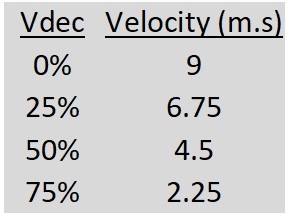
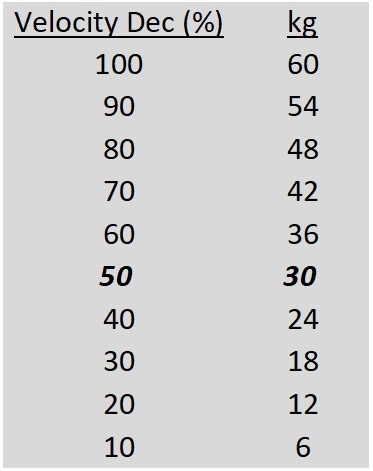
The information beneath is from an athlete who accomplished 2 x 5m accelerations with 30kg of resistance on the 1080 Dash, with the target of a velocity decrement of fifty% (4.5 m/s). The athlete reached a peak velocity of 4.21 m/s on the 5m mark, which is a velocity lack of roughly 53%.



As talked about earlier, the limitation of the primary version 1080 Dash is that it solely goes as much as 30kg, which isn’t heavy sufficient to elicit a 50%–75percentVdec in my extra highly effective athletes. To counter this, I limit the pace of the 1080 Dash twine.
A word of warning—using the speed limit setting on the 1080 Sprint can create some very big technical changes in the sprint, says @jonobward. Click To Tweet
A phrase of warning—utilizing the pace restrict setting can create some very large technical adjustments within the dash. I discover my highly effective athletes can keep stiff by means of the ankle, knee, and hip and drive ahead horizontally. In my much less highly effective athletes, I discover they aren’t sturdy sufficient to keep up good method and sometimes transfer aspect to aspect and “spin the wheels”; in these cases, I lower the speed decrement and solely work to a 60percentVdec.
Beneath are two 5m accelerations the place I needed a 70% velocity loss, which for this athlete was 2.7 m/s.



You may see within the velocity hint that the pace restrict kicked in across the second step. Typically, the athlete will break the pace restrict as they strike the bottom, and above is a major instance of that. The restrict was set at 2.7 m/s; nevertheless, they hit 3.02 m/s. This raises the query of whether or not I ought to decrease the pace restrict additional to keep away from these small spikes in velocity and hold the athlete round 2.7 m/s, however actually, I’ve not performed round with this. For now, I’m completely satisfied to program the pace restrict in accordance with their profile.
One thing attention-grabbing when working at decrease velocity decrements with the pace restrict setting is that I see bigger peak and common energy scores, although I’m working at the next Vdec. One would assume utilizing a resistance that elicits a 50percentVdec would end in larger energy scores, however that isn’t the case, as seen beneath. Each the Pmax and Fmax, along with the typical energy and pressure, had been larger within the 70percentVdec accelerations.
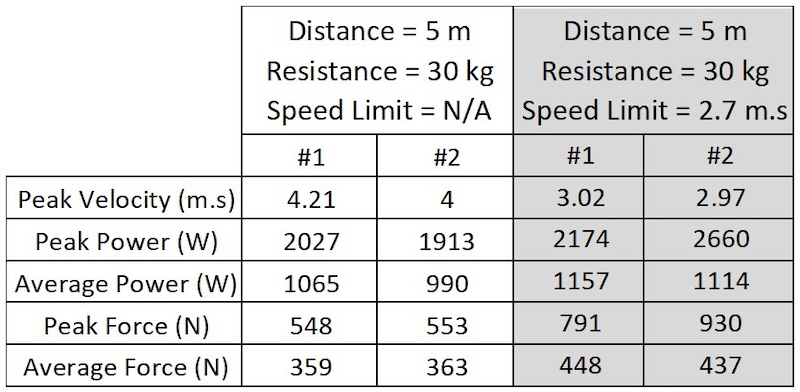
Late Acceleration
If I wish to goal late acceleration (0m–15m), I’ll use masses that elicit 30%–50percentVdec. I perceive 0m–15m just isn’t thought-about “late acceleration” to some coaches, however in rugby, the place most accelerations and sprints are over quick distances,9,10 that is what I take into account late acceleration.
Beneath is an instance of three x 10m accelerations with 30kg of resistance on the 1080 Dash.


You may see the athlete achieves max velocity between the 7m and 9m marks. Their max velocity was 4.48 m/s, which is almost bang on the 50percentVdec for this athlete. With the facility hint, we will see the athlete achieves Pmax between the 7m and 9m marks, which they then maintain by means of to the tip of the run.
Usually, I solely want to make use of the resistance of the 1080 Dash to elicit Pmax; nevertheless, if the athlete requires greater than 30kg to attain Pmax, I’ll use the pace restrict setting. As talked about earlier, there will be detrimental technical adjustments in an athlete’s working method when utilizing the pace restrict setting. That is one thing to contemplate if you’ll use this methodology. You might have an athlete who qualifies to make use of the pace restrict methodology, however once they dash with it, they crumble technically, and you could discover that their energy output just isn’t markedly totally different. In these cases, I’d take into account not utilizing the pace restrict.
Often, I only need to use the resistance of the 1080 Sprint to elicit Pmax; however, if the athlete requires more than 30kg to achieve Pmax, I will use the speed limit setting, says @jonobward. Click To Tweet
Okay, so what does an athlete have to do earlier than I take into account them for the pace restrict methodology?
- The athlete achieves Pmax between the 9m and 10m marks (image beneath).

- The speed the athlete achieved is bigger than their 50percentVdec.

The athlete above certified for the pace restrict methodology since he achieved Pmax between the 9m and 10m marks, and the max velocity of the dash was 5.11 m/s, which was a 44% velocity decrement from his 9.2 m/s max velocity.
Beneath are two 10m accelerations from the identical athlete utilizing totally different loading protocols. The blue hint is the 10m acceleration with an added resistance of 30kg. The inexperienced hint was the 10m acceleration that had a pace restrict of 4.3 m/s (50percentVdec) and a resistance of 15kg.



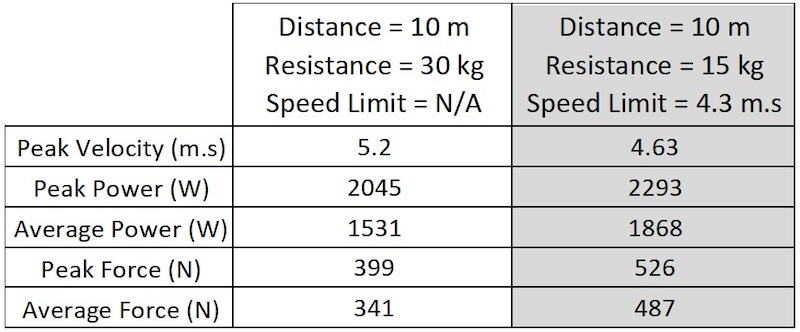
Within the pace restrict protocol (inexperienced hint), you’ll be able to see the athlete reached the 4.3 m/s pace restrict across the 3.5m mark. They hit Pmax shortly after the 4m mark and held it by means of to the tip of the run. Within the 10m acceleration with 30kg of resistance (blue hint), the athlete continued accelerating all through the 10m, ending at 5.2 m/s (above their 50percentVdec), and achieved Pmax within the final meter of the run. Because of the athlete hitting Pmax earlier within the pace restrict protocol, it elevated the 10m common energy by 337 W. In addition they achieved the next Fmax and common pressure.
By way of trial and error, I discovered programming a resistance of 15kg along with the pace restrict works greatest. Once I use the minimal weight doable on the twine (1kg), the athletes explode off the mark, and so they attain their 50percentVdec inside the first 1–3 strides. This sounds supreme, BUT the twine jerks abruptly when the pace restrict kicks in, which causes a noticeable disruption to their method and rhythm.
On the alternative finish, after I put 30kg on the twine, and the athlete accelerates, they may sometimes attain Pmax after the 7m–9m mark, and if they’re solely sprinting 10 meters, it means they’re uncovered to Pmax for 1–3 meters. Once I put a 15kg resistance on the twine, and the athletes speed up, they typically obtain Pmax between the 3- and 4-meter mark, which means they are going to be uncovered to Pmax for six–7 meters. As well as, when the pace restrict kicks in, the method change is simply barely noticeable. Because of this, I take advantage of 15kg of resistance when utilizing the pace restriction.
Beneath is an instance of two 10m accelerations, with the inexperienced hint having a pace restrict of 4.3 m/s along with 15kg and the crimson hint having a pace restrict of 4.3 m/s along with 30kg.

Within the 4.3 m/s and 15kg protocol (inexperienced hint), the athlete hit 50percentVdec and achieved a Pmax of 2347 W round 3.5 meters, and their 10m common energy was 1773 W. For the 4.3 m/s and 30kg protocol (crimson hint), the athlete hit 50percentVdec and achieved a Pmax of 2335 W round 8.4m, and their 10m common energy was 1416 W. Whereas the distinction in peak energy between the 2 runs was small, they differ in when the athlete first hit peak energy. This enormously impacts the typical energy, as seen by the 357 W distinction in favor of the inexperienced hint acceleration.
Transition Part:
If I wish to goal the transition part (10–20 meters), I’ll use masses that elicit a ten%–25% Vdec. I’m restricted by distance in my gymnasium, but when utilizing the 1080 on an extended observe or area, I program longer distances. Beneath are two 20m sprints from the identical athlete. The yellow hint is a 20m acceleration with 1kg of resistance. I included this repetition to provide an understanding of what pace, energy, and forces the athlete produces throughout unweighted sprinting. The inexperienced hint is a dash utilizing 15kg of resistance (25percentVdec).
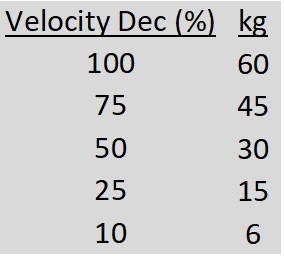



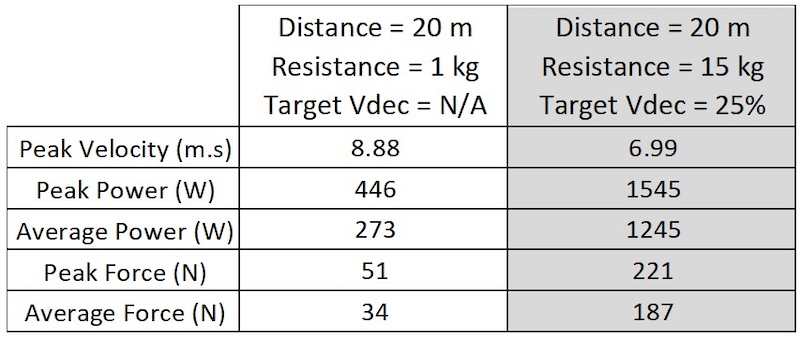
From above, we will see that this athlete hit 8.88 m/s when pulling 1kg (yellow hint), which equates to virtually 99% of their max velocity. I’ll be the primary to confess he is a good accelerator however lacks prime pace. Within the second dash (inexperienced hint), he ran 20m, pulling 15kg, and hit 6.99 m/s, which is 77.5% of his max velocity, or a Vdec of twenty-two.5%. That is within the ballpark for the 25percentVdec. The one factor I seen is that he began to decelerate within the final meter, whereas I’d have preferred him to push by means of to the end.
When programming for the transition phase, I sometimes prescribe variable resistance, says @jonobward. Click To Tweet
When programming for the transition part, I typically prescribe variable resistance. The beginning resistance on the twine is about on the athlete’s 25percentVdec resistance, and the tip resistance is along with their 10percentVdec. Utilizing the athlete’s information from Desk 11, I’d set the beginning resistance at 15kg and the tip resistance at 6kg.
When utilizing the variable resistance setting, I have to additionally set the speed the place the drop-off in resistance stops. I set the beginning resistance at 15 kg (25percentVdec) and program the linear drop-off to cease when the athlete hits their 10percentVdec velocity.
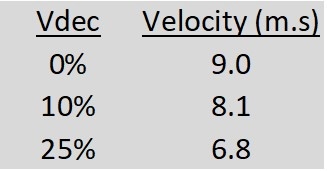
Utilizing the information from the desk above, I’d schedule the drop-off to cease when the athlete hits 8.1 m/s. Due to house within the gymnasium, I’m restricted to utilizing 15m–20m, however in an ideal world, I’d program 20m–40m utilizing this methodology. Something below 15 meters just isn’t lengthy sufficient, and even then, some athletes who’re slower accelerators or have excessive top-end pace received’t attain 10percentVdec earlier than 20m.
4. Enhancements from RST
The purpose of RST is to turn out to be sooner. With my group, I take a look at the efficacy of the intervention in certainly one of 3 ways:
- A 20m dash on the 1080, wanting on the 5m splits.
- Full an LVP or LPP and examine the outcomes from the earlier profile.
- In session, by wanting on the energy output the athlete produces when utilizing the identical resistance.
Beneath is an instance of utilizing the third methodology. I ran a familiarization protocol lately, accomplished load energy profiles with the squad, after which ran a six-week intervention the place athletes ran 3 x 10m on the resistance that elicited their Pmax. Beneath are 11 backs (I unnoticed any participant who missed a number of classes), and you’ll see that six classes had been sufficient to enhance gamers’ peak energy.
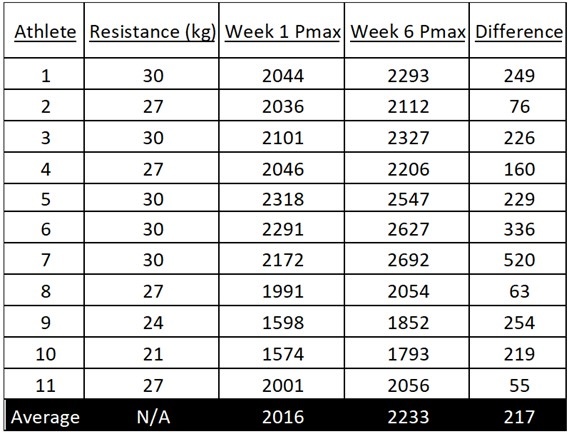
Final season, I accomplished two interventions, aspect by aspect, on the 1080 Dash with 9 backs and 6 again rowers. (In the event you aren’t acquainted with rugby however know American soccer, these guys are like rugby’s model of linebackers.) I ran a 50percentVdec intervention, concentrating on acceleration, which consisted of three x 10m sprints accomplished contained in the gymnasium session.
Of the ten gamers, solely seven accomplished the pre-20m take a look at, six-week intervention, and post-20m take a look at. The opposite intervention targeted on the transition part, the place I had athletes dash 15 meters with variable resistance on the twine, beginning at 25percentVdec and ending at 10percentVdec. These athletes had been my good accelerators, and so they hit 25percentVdec round 8m–10m.
I admit that the athletes hardly ever completed the 15m at their 10percentVdec resulting from house limitations. I’d have preferred to make use of 20m, however that shall be for a future intervention! Of the 5 gamers on this group, solely 4 accomplished the intervention and testing. Beneath are the outcomes.
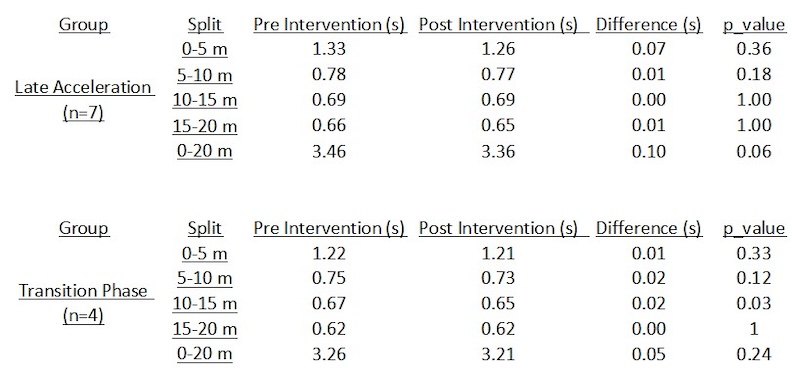
What stands out to me is the 0.08-second enchancment within the 0m–10m cut up for the 50percentVdec group and the numerous enchancment within the 10m–15m cut up for the transition part group. No enhancements had been seen within the 15m–20m cut up, which doesn’t shock me for 2 causes, largely regarding the SAID precept (particular adaptation to imposed calls for).
- We didn’t prepare this a part of the dash within the intervention.
- The athlete hardly ever sprints 20m–40m all out throughout the week to elicit enhancements.
One closing word!
For individuals who should not have a 1080 Dash, sadly, you can’t examine your information to the above. Even totally different beginning positions utilizing pace gates will end in efficiency variations11; nevertheless, I do know that as practitioners, we nonetheless like to match, so beneath is information from a 20m dash utilizing the 1080 Dash and pace gates.
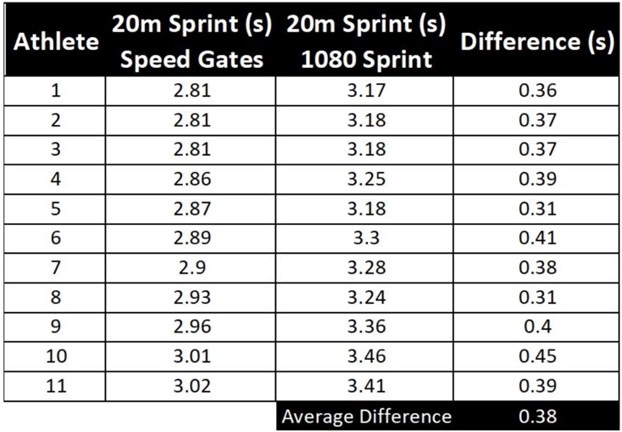
The common distinction of 0.38 seconds, in favor of pace gates, is just like the examine by Rakovic et al.12 the place they discovered a distinction of 0.31 seconds additionally in favor of the pace gates. The authors discovered that the distinction in time between the 2 timing strategies occurred throughout the 0–5m cut up and associated to the set off movement of the dash. The set off of the 1080 Dash is extra delicate than a timing gate and, in my view, extra correct, because it responds to any motion above 0.2 m/s.
The trigger of the 1080 Sprint is more sensitive than a timing gate and, in my opinion, more accurate, as it responds to any movement above 0.2 m/s, says @jonobward. Click To Tweet
Experiment with the 1080 Dash on Your Personal
I’ve no affiliation with the 1080 Dash, but it is likely one of the greatest instruments accessible for coaching the dash. The flexibility to individually profile and program means you will be correct in your prescription. In case you are fortunate sufficient to have entry to a 1080 Dash, you could discover your group setting could possibly be very totally different from mine, and this dictates how you need to use it.
Once I was with one other group, we used the 1080 Dash a minimum of twice per week, and typically 3 times per week, to nice impact. I encourage you to mess around on the machine, be a guinea pig your self, and share what you discover!
Because you’re right here…
…we have now a small favor to ask. Extra persons are studying SimpliFaster than ever, and every week we deliver you compelling content material from coaches, sport scientists, and physiotherapists who’re dedicated to constructing higher athletes. Please take a second to share the articles on social media, have interaction the authors with questions and feedback beneath, and hyperlink to articles when acceptable you probably have a weblog or take part on boards of associated subjects. — SF
References
1. Costello, F. “Velocity: Coaching for Velocity Utilizing Resisted and Assisted Strategies.” Power & Conditioning Journal. 1985;7:74.
2. Cronin J and Hansen KT. “Resisted Dash Coaching for the Acceleration Part of Sprinting.” Power & Conditioning Journal. 2006;28:42.
3. Lockie R, Murphy A, and Spinks C. “Results of Resisted Sled Towing on Dash Kinematics in Area-Sport Athletes.” Journals of Power and Conditioning Analysis/Nationwide Power & Conditioning Affiliation. 2003;17:760–767. doi:10.1519/1533-4287(2003)017<0760:EORSTO>2.0.CO;2.
4. Petrakos G, Morin J-B, and Egan B. “Resisted Sled Dash Coaching to Enhance Dash Efficiency: A Systematic Evaluate.” Sports activities Drugs. 2016;46:381–400. Doi:10.1007/s40279-015-0422-8.
5. Alcarez PE, Carlos-Vivas J, Oponjuru BO, and Martínez-Rodríguez A. “The Effectiveness of Resisted Sled Coaching (RST) for Dash Efficiency: A Systematic Evaluate and Meta-Evaluation.” Sports activities Drugs (Auckland, NZ). 2018;48:2143–2165. doi:10.1007/s40279-018-0947-8.
6. Cross MR, Brughelli M, Samozino P, Brown SR, and Morin J-B. “Optimum Loading for Maximizing Energy Throughout Sled-Resisted Sprinting.” Worldwide Journal of Sports activities Physiology and Efficiency. 2017;12:1069–1077. doi:10.1123/ijspp.2016-0362.
7. Cahill MJ, Oliver JL, Cronin JB, Clark KP, Cross MR, and Lloyd RS. “Sled-Pull Load-Velocity Profiling and Implications for Dash Coaching Prescription in Younger Male Athletes.” Sports activities. 2019;7:119. doi:10.3390/sports7050119.
8. von Lieres und Wilkau HC, Irwin G, Bezodis NE, Simpson S, and Bezodis IN. “Part Evaluation in Maximal Sprinting: An Investigation of Step-by-Step Technical Modifications between the Preliminary Acceleration, Transition and Maximal Velocity Phases.” Sports activities Biomechanics. 2020;19:141–156. doi:10.1080/14763141.2018.1473479.
9. Nicholson B, Dinsdale A, Jones B, and Until Okay. “The Coaching of Quick Distance Dash Efficiency in Soccer Code Athletes: A Systematic Evaluate and Meta-Evaluation.” Sports activities Drugs. 2021;51:1179–1207. doi:10.1007/s40279-020-01372-y.
10. Nicholson B, Dinsdale A, Jones B, and Until Okay. “The Coaching of Medium- to Lengthy-Distance Dash Efficiency in Soccer Code Athletes: A Systematic Evaluate and Meta-Evaluation.” Sports activities Drugs. 2022;52:257–286. doi:10.1007/s40279-021-01552-4.
11. Weakley J, McCosker C, Chalkley D, Johnston R, Munteanu G, and Morrison M. “Comparability of Dash Timing Strategies on Efficiency, and Displacement and Velocity at Timing Initiation.” Journal of Power and Conditioning Analysis. 2023;37:234–238. doi:10.1519/JSC.0000000000004223.
12. Rakovic E, Paulsen G, Helland C, Haugen T, and Eriksrud O. “Validity and Reliability of a Motorized Dash Resistance System.” Journal of Power and Conditioning Analysis. 2022;36:2335–2338. doi:10.1519/JSC.0000000000003830.
